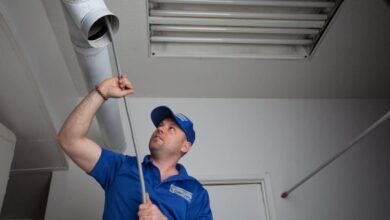The Importance of Fume Hoods in Modern Laboratory Safety and Efficiency
In laboratories worldwide, safety, efficiency, and environmental protection are non-negotiable priorities. Among the most critical pieces of equipment designed to protect both laboratory personnel and the surrounding environment is the Fume Hood. This vital tool plays a pivotal role in ensuring that laboratory workers are safeguarded from hazardous fumes, vapors, and particles that can be generated during experiments.
This article will dive into the significance of fume hoods, their operational mechanisms, the types available, and why they are an essential component in laboratory safety protocols. Furthermore, we will explore how laboratories can benefit from choosing the right fume hood solutions and the latest innovations that contribute to modern laboratory design.
What is a Fume Hood?
A fume hood is a specialized piece of laboratory furniture designed to prevent the release of hazardous chemicals, gases, and particulate matter into the laboratory environment. By ventilating harmful fumes and maintaining airflow patterns, fume hoods ensure that laboratory staff remain safe while conducting potentially dangerous experiments. These units are equipped with exhaust fans, filters, and a properly designed enclosure to protect users from inhaling toxic substances.
Fume hoods are essential in controlling laboratory air quality and mitigating the risks associated with handling volatile chemicals. Their proper use ensures compliance with safety regulations and helps minimize workplace health risks.
How Fume Hoods Work
At the core of any fume hood’s functionality is its ability to create a controlled airflow. Typically, fume hoods are equipped with a sash (the sliding window) that can be adjusted to allow optimal airflow. When chemicals are handled inside the hood, the system creates negative pressure, drawing air into the enclosure to capture and expel hazardous substances safely.
The exhaust system then carries the air through ducts and filters to the outside of the building, preventing contaminants from circulating throughout the laboratory. The filters used in modern fume hoods are designed to handle different types of hazards, from chemical vapors to particulate matter, depending on the needs of the specific laboratory.
Types of Fume Hoods
Not all fume hoods are the same. They come in various designs tailored to different types of laboratories and specific needs. The main categories include:
- Constant Air Volume (CAV) Fume Hoods
- CAV fume hoods maintain a constant airflow rate regardless of the sash position. While they provide consistent air quality, they can be less energy-efficient compared to other designs.
- Variable Air Volume (VAV) Fume Hoods
- VAV fume hoods adjust airflow rates based on the position of the sash, improving energy efficiency. This system is especially beneficial for labs that prioritize sustainability and reducing energy costs.
- Biological Safety Cabinets
- Designed for laboratories working with biological agents, these fume hoods provide a sterile environment while protecting the user from exposure to harmful organisms.
- Aseptic Fume Hoods
- Used primarily in pharmaceutical and medical laboratories, aseptic hoods maintain both a sterile environment and a safe working space for chemicals that require protection from contamination.
Why Fume Hoods are Critical for Laboratory Safety
The necessity of fume hoods in laboratories cannot be overstated. Laboratories, whether they focus on chemistry, biology, or any other scientific discipline, are often filled with potentially dangerous materials that pose significant health risks. Here’s how fume hoods contribute to laboratory safety:
1. Protecting Laboratory Workers
The primary function of a fume hood is to protect laboratory personnel from inhaling hazardous fumes, gases, or particulate matter. Laboratories are often filled with substances that, when mishandled, can lead to serious health issues, including respiratory problems, chemical burns, and even long-term diseases. Fume hoods significantly reduce these risks by ensuring harmful substances are captured and removed from the work environment.
2. Preventing Contamination
In addition to safeguarding workers, fume hoods also prevent the spread of contaminants into the broader laboratory environment. Many chemicals used in laboratories are not only harmful to human health but can also compromise the integrity of sensitive experiments. By containing these substances, fume hoods help maintain the purity of other experiments and prevent cross-contamination.
3. Compliance with Safety Standards
Workplace safety regulations worldwide require laboratories to adhere to strict guidelines for handling hazardous materials. Fume hoods are integral to meeting these requirements, as they are designed to comply with local and international safety standards. Ensuring that a laboratory is equipped with a suitable fume hood helps the facility pass safety audits and inspections with ease.
Fume Hood Maintenance and Care
While fume hoods are robust tools, they still require regular maintenance to ensure their proper function. The efficiency of the airflow and exhaust system depends on consistent care. Routine maintenance includes checking the exhaust system, ensuring that filters are replaced regularly, and verifying that the airflow speed remains optimal.
Improper maintenance can lead to reduced efficiency, increased energy consumption, and even failure of the fume hood to effectively capture harmful substances. It’s also important to periodically calibrate the airflow to ensure that it remains at the correct rate for safe operation.
The Future of Fume Hoods in Laboratory Design
As laboratories continue to evolve in their approach to safety, energy conservation, and environmental impact, fume hoods have undergone significant technological advancements. Here are some of the key trends shaping the future of fume hood technology:
1. Energy-Efficiency Innovations
One of the leading trends is the push for more energy-efficient fume hoods. With rising energy costs and the increasing focus on sustainability, laboratories are seeking systems that minimize energy consumption without compromising safety. The development of VAV fume hoods, which adjust airflow based on the sash’s position, is a significant step toward reducing energy usage in laboratories.
2. Smart Fume Hoods
Another exciting innovation is the integration of smart technology into fume hoods. These smart systems can monitor air quality in real-time, alert laboratory staff when maintenance is due, and even adjust airflow automatically based on environmental factors. This level of sophistication improves safety, saves energy, and ensures that laboratory personnel can focus on their work with peace of mind.
3. Sustainability and Environmental Protection
As the world focuses more on sustainability, laboratory equipment manufacturers are designing fume hoods with the environment in mind. This includes using recyclable materials, energy-efficient components, and reducing the carbon footprint of the manufacturing process itself.
Conclusion: Why Fume Hoods Are an Investment in Laboratory Safety
Fume hoods are no longer just a piece of equipment—they are integral to ensuring the safety, efficiency, and environmental sustainability of laboratories around the world. By protecting workers, maintaining experiment integrity, and complying with safety regulations, fume hoods play an essential role in laboratory operations.
As technology continues to evolve, the future of fume hoods looks promising, with smarter, more energy-efficient solutions on the horizon. Laboratories that invest in high-quality fume hoods will not only protect their staff and the environment but also enhance their overall operational efficiency and compliance.
In a rapidly advancing scientific world, the fume hood remains a cornerstone of laboratory safety and success. As laboratories strive to innovate and push the boundaries of scientific discovery, ensuring that proper safety equipment, such as fume hoods, remains in place is critical for continuing progress in a safe and responsible manner.



